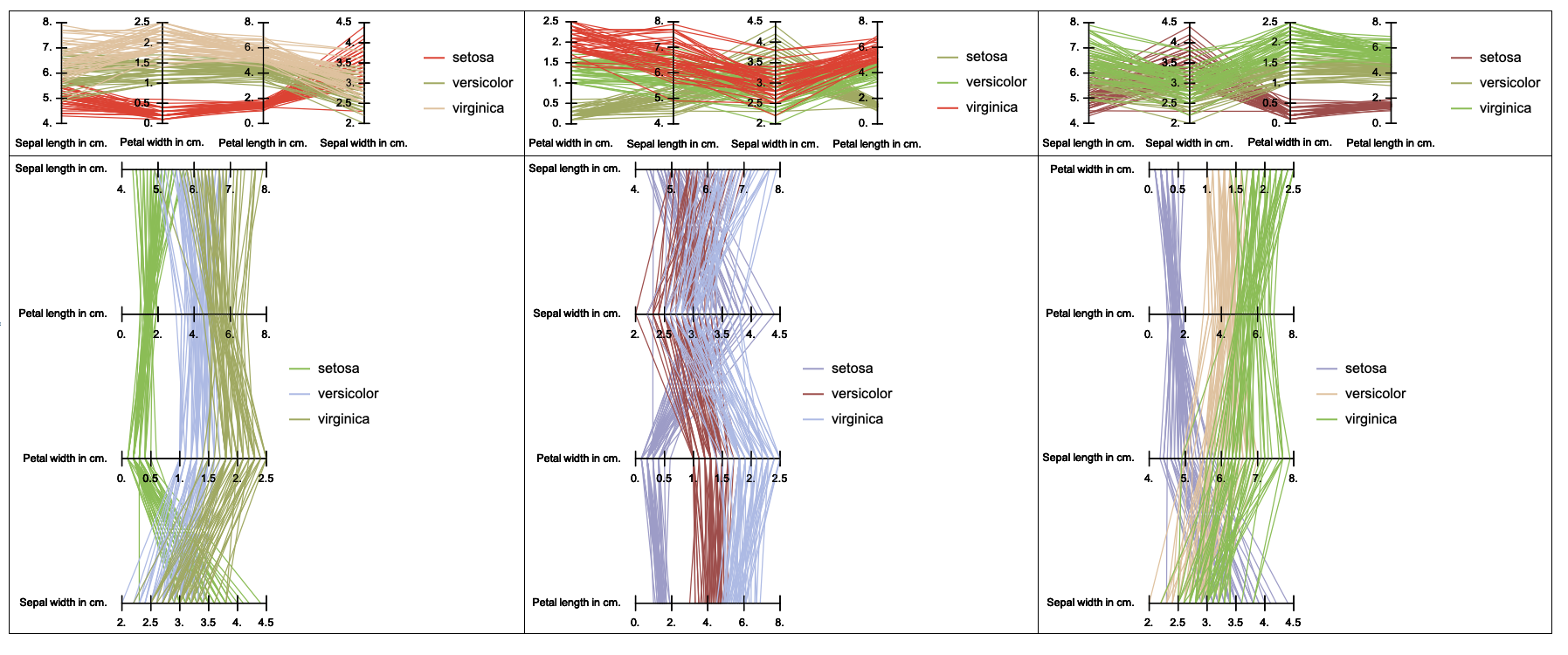Wolfram Function Repository function
Here is a WFR candidate ParallelCoordinatesPlot :
Package
I implemented the package "ParallelCoordinatesPlot.m" for doing this kind of plots and put it in GitHub. I plan to improve it some more. It is especially interesting to have automatic selection of the axes order that produces most discernible results.
Import["https://raw.githubusercontent.com/antononcube/MathematicaForPrediction/master/Misc/ParallelCoordinatesPlot.m"]
data = ExampleData[{"Statistics", "FisherIris"}];
colNames = ExampleData[{"Statistics", "FisherIris"}, "ColumnDescriptions"];
aData = GroupBy[data, #[[-1]] &, #[[All, 1 ;; -2]] &];
grs = Table[ParallelCoordinatesPlot[aData, Most[colNames], "Colors" -> Random, "AxesOrder" -> Random, Direction -> dir, ImageSize -> Medium], {dir, {"Horizontal", "Vertical"}}, {m, 3}];
Grid[grs, Alignment -> Left, Dividers -> All]
First answer
Below is given a function definition to do this. It can be improved and "productized" some more, especially with legend's colors specification. (Currently random colors are picked from a hard coded color scheme.)
Get the "Fisher Iris" data and columns names:
data = ExampleData[{"Statistics", "FisherIris"}];
colNames = ExampleData[{"Statistics", "FisherIris"}, "ColumnDescriptions"]
Group the data according to the species of iris:
aData = GroupBy[data, #[[-1]] &, #[[All, 1 ;; -2]] &];
Make the parallel plot:
ParallelListLinePlot[aData, Most[colNames]]
(Several plot evaluations might be needed in order to produce more discernible coloring.)
Definition
Clear[ParallelListLinePlot];
ParallelListLinePlot[data_?MatrixQ, opts : OptionsPattern[]] :=
ParallelListLinePlot[data, Range[Length[data[[1]]]], MinMax /@ Transpose[data], opts];
ParallelListLinePlot[data_?MatrixQ, colNames_List, opts : OptionsPattern[]] :=
ParallelListLinePlot[data, colNames, MinMax /@ Transpose[data], opts];
ParallelListLinePlot[data_?MatrixQ, colNames_List, minMaxes_?MatrixQ, opts : OptionsPattern[]] :=
Block[{divisions, data2, grBase, grid, xs, n = 5, c = 0.1},
divisions = FindDivisions[#, n] & /@ minMaxes;
data2 =
Transpose[
MapThread[
Rescale[#1, #2, {0, 1}] &, {Transpose[data],
MinMax /@ divisions}]];
xs = Range[Length[data[[1]]]];
grBase =
ListLinePlot[data2, opts, Axes -> False,
GridLines -> {Range[Length[data[[1]]]], None}];
grid =
Graphics[{
Line[{{#, 0}, {#, 1}}] & /@ xs,
MapThread[
Function[{x, ds},
MapThread[{Line[{{x - c, #2}, {x + c, #2}}],
Text[#1, {x - c, #2}, {2, 0}]} &, {N@ds, Rescale[ds]}]
],
{xs, divisions}],
MapThread[Text[#2, {#1, 0}, {0, 3}] &, {xs, colNames}]
}];
Show[grBase, grid]
] /; MatrixQ[data, NumberQ] && MatrixQ[minMaxes, NumberQ] &&
Dimensions[minMaxes] == {Dimensions[data][[2]], 2};
ParallelListLinePlot[aData_Association, colNames_List, opts : OptionsPattern[]] :=
Block[{minMaxes, cols, grs},
minMaxes = MinMax /@ Transpose[Join @@ Values[aData]];
cols = RandomSample[ColorData[11, "ColorList"], Length[aData]];
grs =
MapThread[
ParallelListLinePlot[#1, colNames, minMaxes, PlotStyle -> #2,
opts] &, {Values@aData, cols}];
Legended[Show[grs], SwatchLegend[cols, Keys[aData]]]
] /; MatrixQ[Join @@ Values[aData], NumberQ];



